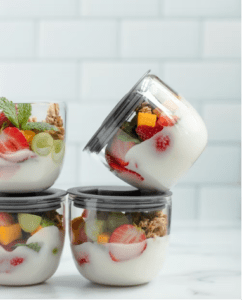With back to school season approaching fast, the stress of feeding busy kids, tweens, and/or teenagers may be on the horizon for many. Gone are the relaxing summer days filled with impromptu barbecues and frozen sweets galore – the kids’ days are now packed to the brim with schoolwork, sports, and activities, leaving little room for error when it comes to feeding them in the most beneficial way for their new schedule. Whether your kids are entering preschool, or starting senior year, this blog post will provide parents and caretakers with effective tips on how to win in the kitchen this back to school season!
Foods for Big Brains and Active Bodies
 School-aged children are not only growing, but they’re learning and moving, so they need food that can support them inside and outside the classroom. It can be easy to get caught up in schoolwork and after-school activities, so ensure to opt for meals and snacks that will keep the kids full and energized all day long! All children will have slightly different needs depending on the type of activities they’re involved in, but knowing the basics of some macro and micronutrients is key to choosing balanced and nutritious school lunches and snacks.
School-aged children are not only growing, but they’re learning and moving, so they need food that can support them inside and outside the classroom. It can be easy to get caught up in schoolwork and after-school activities, so ensure to opt for meals and snacks that will keep the kids full and energized all day long! All children will have slightly different needs depending on the type of activities they’re involved in, but knowing the basics of some macro and micronutrients is key to choosing balanced and nutritious school lunches and snacks.
Carbohydrates
These are arguably the easiest macronutrient to include in a kid’s diet (who doesn’t love bread, crackers, and cereal!), but choosing fibre-rich sources of carbohydrates is essential to keep children of all ages satisfied and energized. Try to include more whole grain carbohydrates, like whole wheat pasta, brown rice, and oats, which digest slower and will help prevent that dreaded afternoon crash often associated with lower fibre, higher sugar meals and snacks (1).
Protein
This macronutrient is essential for growth and development in children, and it is especially important for growing (2) and maintaining strong bones and muscles (3). This is even more relevant for children involved in sports and other physical activities after school. Protein is also a key nutrient in kids’ meals and snacks since it provides long lasting satiety, since it is slower to digest and break down than carbohydrates (4). Try to include a source of protein with every meal and snack, such as greek yogurt, eggs, chicken, cheese, meat, fish, beans and legumes.
Micronutrients
It might seem overwhelming to look at long and complicated tables detailing all the micronutrient needs for children, but as long as the kids’ diets include a variety of foods from different food groups, there’s not much to worry about! Try to get some nutrient-rich veggies and fruits at least twice a day, or at every meal and snack if possible. Whether fresh, frozen, or canned, produce contains important micronutrients for children’s development and overall health, such as Vitamins A, B12, C, and D, as well as zinc and iron (5).
Time-saving Tricks for the on-the-go Family
 The school year is a busy time for kids and parents alike, so here are some helpful tips to save time and energy when feeding the whole family on a tight schedule:
The school year is a busy time for kids and parents alike, so here are some helpful tips to save time and energy when feeding the whole family on a tight schedule:
- Spend a few minutes at the beginning of the week making a weekly lunch and/or dinner to ensure you can shop and prep accordingly and be ready to take on the busy week.
- Don’t be afraid of frozen foods! Having frozen veggies on hand to quickly steam or roast is a great option to add some extra nutrients to a less balanced item, like pasta with sauce. Frozen fruits also make for great breakfast smoothie ingredients. If your kid is absolutely obsessed with frozen chicken nuggets, don’t be afraid to make those either! All foods can fit into a balanced diet, and you can feel at ease knowing your child will eat their portion and enjoy it. For a helpful list of frozen foods to keep on hand, check out our FREE Staple Freezer list here.
- Try out batch cooking. Batch cooking is the process of cooking a large batch of a staple ingredient to save time throughout the week, rather than cooking a new batch each time. If your family loves rice, try cooking a large batch on Sunday night and storing it in an airtight container in the fridge – then you have prepared rice ready to quickly reheat all throughout the week!
- To save time on snacks, create fun, pre-portioned “snack bags” that include different snacks such as cheese strings, crackers, veggie sticks, yogurt tubes, and fruit cups. This way, they’re all ready to throw in the lunchbox on a busy morning. Alternatively, you could arrange prepackaged snacks into “pick one” and “pick two” baskets, and have the kids quickly assemble their lunch box the way they like it!
Get Inspired!
 Getting the kids involved in meal planning and preparation is a great way to ensure smooth sailing this school year. Don’t be afraid to broaden your horizons and try something new, like searching for fun and easy recipes online together. You can then do a “trial run” of new recipes at dinner time, or even on the weekend, and if the kids enjoy it, it can be added to the lunch roster.
Getting the kids involved in meal planning and preparation is a great way to ensure smooth sailing this school year. Don’t be afraid to broaden your horizons and try something new, like searching for fun and easy recipes online together. You can then do a “trial run” of new recipes at dinner time, or even on the weekend, and if the kids enjoy it, it can be added to the lunch roster.
Something as simple as packing lunch for school has a huge impact on whether the lunch is enjoyed or even eaten. You can check our complete guide to packing school lunches here, which includes the important benefits of having kids involved in the process, as well as some ingredient inspiration and lunch ideas.
Back to school season doesn’t need to be daunting, as long as you have the right tools and resources to feed hungry kids and adults alike! If you are worried or concerned about your child’s diet look no further, our team is here to support you. Book a free discovery call with Maiya, our registered dietitian who specializes in pediatric, toddler and preschoolers health.




